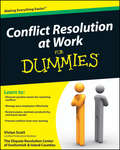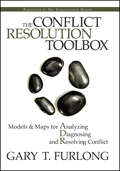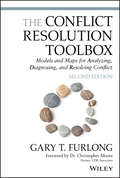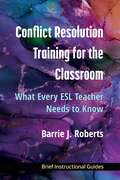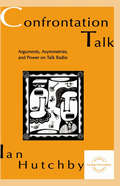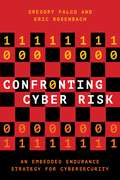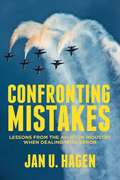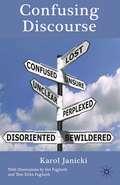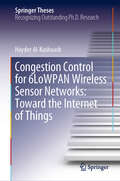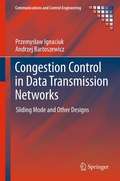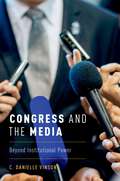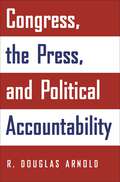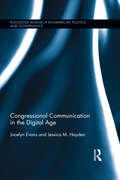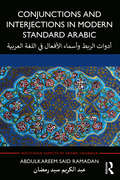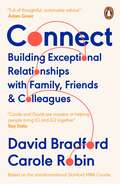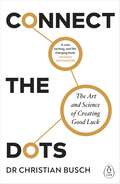- Table View
- List View
Conflict Resolution at Work For Dummies
by Vivian ScottA practical workplace guide to handling conflict effectively Managing employees and encouraging them to work together toward a common goal is an essential skill that all leaders should possess. Conflict Resolution at Work For Dummies provides the tools and advice you need to restore peace, train your colleagues to get along better with others, prevent conflicts from ever starting, and maintain better productivity while boosting morale. One of the only trade publications that takes the manager's perspective on how to address conflicts, resolve disputes, and restore peace and productivity to the workplace Examines more positive means for resolving conflicts (other than arguing, surrendering, running away, filing a lawsuit, etc.) Helps managers and employees sort through problems and make the workplace a more rewarding place No manager should be without Conflict Resolution at Work For Dummies!
Conflict Resolution at Work For Dummies
by Vivian ScottA practical workplace guide to handling conflict effectively Managing employees and encouraging them to work together toward a common goal is an essential skill that all leaders should possess. Conflict Resolution at Work For Dummies provides the tools and advice you need to restore peace, train your colleagues to get along better with others, prevent conflicts from ever starting, and maintain better productivity while boosting morale. One of the only trade publications that takes the manager's perspective on how to address conflicts, resolve disputes, and restore peace and productivity to the workplace Examines more positive means for resolving conflicts (other than arguing, surrendering, running away, filing a lawsuit, etc.) Helps managers and employees sort through problems and make the workplace a more rewarding place No manager should be without Conflict Resolution at Work For Dummies!
The Conflict Resolution Toolbox: Models and Maps for Analyzing, Diagnosing, and Resolving Conflict
by Gary T. FurlongIn real-life conflict resolution situations, one size does not fit all. Just as a mechanic does not fix every car with the same tool, the conflict resolution practitioner cannot hope to resolve every dispute using the same technique. Practitioners need to be comfortable with a wide variety of tools to diagnose different problems, in vastly different circumstances, with different people, and resolve these conflicts effectively. The Conflict Resolution Toolbox gives you all the tools you need: eight different models for dealing with the many conflict situations you encounter in your practice. This book bridges the gap between theory and practice and goes beyond just one single model to present a complete toolbox - a range of models that can be used to analyze, diagnose, and resolve conflict in any situation. It shows mediators, negotiators, managers, and anyone needing to resolve conflict how to simply and effectively understand and assess the situations of conflict they face. And it goes a step further, offering specific, practical guidance on how to intervene to resolve the conflict successfully. Each model provides a different and potentially useful angle on the problem, and includes worksheets and a step-by-step process to guide the reader in applying the tools. Offers eight models to help you understand the root causes of any conflict. Explains each model's focus, what kind of situations it can be useful in and, most importantly, what interventions are likely to help. Provides you with clear direction on what specific actions to choose to resolve a particular type of conflict effectively. Features a detailed case study throughout the book, to which each model is applied. Additional examples and case studies unique to each chapter give the reader a further chance to see the models in action. Includes practical tools and worksheets that you can use in working with these models in your practice. The Conflict Resolution Toolbox equips any practitioner to resolve a wide range of conflicts. Mediators, negotiators, lawyers, managers and supervisors, insurance adjusters, social workers, human resource and labour relations specialists, and others will have all the tools they need for successful conflict resolution.
The Conflict Resolution Toolbox: Models and Maps for Analyzing, Diagnosing, and Resolving Conflict
by Gary T. FurlongIn real-life conflict resolution situations, one size does not fit all. Just as a mechanic does not fix every car with the same tool, the conflict resolution practitioner cannot hope to resolve every dispute using the same technique. Practitioners need to be comfortable with a wide variety of tools to diagnose different problems, in vastly different circumstances, with different people, and resolve these conflicts effectively. The Conflict Resolution Toolbox gives you all the tools you need: eight different models for dealing with the many conflict situations you encounter in your practice. This book bridges the gap between theory and practice and goes beyond just one single model to present a complete toolbox - a range of models that can be used to analyze, diagnose, and resolve conflict in any situation. It shows mediators, negotiators, managers, and anyone needing to resolve conflict how to simply and effectively understand and assess the situations of conflict they face. And it goes a step further, offering specific, practical guidance on how to intervene to resolve the conflict successfully. Each model provides a different and potentially useful angle on the problem, and includes worksheets and a step-by-step process to guide the reader in applying the tools. Offers eight models to help you understand the root causes of any conflict. Explains each model's focus, what kind of situations it can be useful in and, most importantly, what interventions are likely to help. Provides you with clear direction on what specific actions to choose to resolve a particular type of conflict effectively. Features a detailed case study throughout the book, to which each model is applied. Additional examples and case studies unique to each chapter give the reader a further chance to see the models in action. Includes practical tools and worksheets that you can use in working with these models in your practice. The Conflict Resolution Toolbox equips any practitioner to resolve a wide range of conflicts. Mediators, negotiators, lawyers, managers and supervisors, insurance adjusters, social workers, human resource and labour relations specialists, and others will have all the tools they need for successful conflict resolution.
The Conflict Resolution Toolbox: Models and Maps for Analyzing, Diagnosing, and Resolving Conflict
by Gary T. FurlongPRAISE FOR THE CONFLICT RESOLUTION TOOLBOX SECOND EDITION "I have been using and recommending The Conflict Resolution Toolbox since its first edition. It is rare to find a resource with such practical tools in a field that is so concrete, but often struggles to bridge theory and practice. In this increasingly complex world, it is vital to have models to resort to when we reach impasse in conflict. I recommend The Conflict Resolution Toolbox to anyone engaged in resolving conflicts in any discipline." —Martha E. Simmons, JD, LLM, PHD, Academic Director, Winkler Institute of Dispute Resolution and Director, Mediation Clinic and Intensive Program, Toronto, Canada "We all know one thing about conflict: It is messy! Furlong's models offer mediators, facilitators, lawyers, psychotherapists and others 'a leg up' in more swiftly figuring out what is going on and what is needed. Furlong does not offer up a single 'truth', style or theory, so much as a collection of effective tools that professionals, groups and families can use to better understand what they are experiencing and how they can approach achieving better results. Highly recommended!" —James C. Melamed, JD, CEO, Mediate.com "Gary Furlong has done it again! A long-time leader in the conflict resolution field, Gary has added two new 'power tools' to what was already the essential conflict resolution toolkit. His new chapters in this Second Edition deal with 'The Law of Reciprocity' and 'Loss Aversion Bias'. I am proud and thankful to add this book to my already growing conflict resolution bookcase, knowing that this is a volume I will go to again and again. I highly recommend it for anyone in the field." —Rick Weiler, Mediator, Arbitrator, Weiler ADR Inc., Ottawa, Canada "Gary Furlong uniquely provides invaluable, practical tools that help in understanding, preventing, and resolving conflict. This is a must-have reference book for anyone who cares about mitigating the role destructive conflict plays in our professional and personal lives and finding strategic benefit in tools that work. Gary has created a book that is both aspirational and practical. It's so challenging to create simple-to-use tools supported by complex concepts and Gary does this better than anyone." —Joshua A. Gordon, JD, MA, Arbitrator for the Court of Arbitration of Sport, Senior Practitioner at the Sports Conflict Institute, and Woodard Family Foundation Fellow Senior Instructor of Sports Business at the University of Oregon Lundquist College of Business
The Conflict Resolution Toolbox: Models and Maps for Analyzing, Diagnosing, and Resolving Conflict
by Gary T. FurlongPRAISE FOR THE CONFLICT RESOLUTION TOOLBOX SECOND EDITION "I have been using and recommending The Conflict Resolution Toolbox since its first edition. It is rare to find a resource with such practical tools in a field that is so concrete, but often struggles to bridge theory and practice. In this increasingly complex world, it is vital to have models to resort to when we reach impasse in conflict. I recommend The Conflict Resolution Toolbox to anyone engaged in resolving conflicts in any discipline." —Martha E. Simmons, JD, LLM, PHD, Academic Director, Winkler Institute of Dispute Resolution and Director, Mediation Clinic and Intensive Program, Toronto, Canada "We all know one thing about conflict: It is messy! Furlong's models offer mediators, facilitators, lawyers, psychotherapists and others 'a leg up' in more swiftly figuring out what is going on and what is needed. Furlong does not offer up a single 'truth', style or theory, so much as a collection of effective tools that professionals, groups and families can use to better understand what they are experiencing and how they can approach achieving better results. Highly recommended!" —James C. Melamed, JD, CEO, Mediate.com "Gary Furlong has done it again! A long-time leader in the conflict resolution field, Gary has added two new 'power tools' to what was already the essential conflict resolution toolkit. His new chapters in this Second Edition deal with 'The Law of Reciprocity' and 'Loss Aversion Bias'. I am proud and thankful to add this book to my already growing conflict resolution bookcase, knowing that this is a volume I will go to again and again. I highly recommend it for anyone in the field." —Rick Weiler, Mediator, Arbitrator, Weiler ADR Inc., Ottawa, Canada "Gary Furlong uniquely provides invaluable, practical tools that help in understanding, preventing, and resolving conflict. This is a must-have reference book for anyone who cares about mitigating the role destructive conflict plays in our professional and personal lives and finding strategic benefit in tools that work. Gary has created a book that is both aspirational and practical. It's so challenging to create simple-to-use tools supported by complex concepts and Gary does this better than anyone." —Joshua A. Gordon, JD, MA, Arbitrator for the Court of Arbitration of Sport, Senior Practitioner at the Sports Conflict Institute, and Woodard Family Foundation Fellow Senior Instructor of Sports Business at the University of Oregon Lundquist College of Business
Conflict Resolution Training for the Classroom: What Every ESL Teacher Needs to Know
by Barrie RobertsESL instructors without a background in conflict resolution (CR) who teach intermediate to advanced courses at colleges, universities, or in Intensive English Programs, may want to provide students with valuable negotiation and mediation skills. Author Barrie J. Roberts is an experienced ESL teacher, lawyer, mediator, and Alternative Dispute Resolution (ADR) Administrator for southern California Superior Courts. In this book, she draws upon her experience using these activities in a variety of ESL settings and courses with students from all over the world to inspire other ESL teachers to add CR approaches to their activities, lessons, and courses. Following an introduction to conflict resolution, Conflict Resolution Training for the Classroom shows how much of the teaching of CR is similar to teaching ESL. It outlines ways to apply negotiation and mediation to ESL activities, how to prevent and resolve conflicts, how to use specific types of role-plays to address conflicts, and how to design successful activities. The book also includes a list of resources and sample syllabi.
Conflict Resolution Training for the Classroom: What Every ESL Teacher Needs to Know
by Barrie RobertsESL instructors without a background in conflict resolution (CR) who teach intermediate to advanced courses at colleges, universities, or in Intensive English Programs, may want to provide students with valuable negotiation and mediation skills. Author Barrie J. Roberts is an experienced ESL teacher, lawyer, mediator, and Alternative Dispute Resolution (ADR) Administrator for southern California Superior Courts. In this book, she draws upon her experience using these activities in a variety of ESL settings and courses with students from all over the world to inspire other ESL teachers to add CR approaches to their activities, lessons, and courses. Following an introduction to conflict resolution, Conflict Resolution Training for the Classroom shows how much of the teaching of CR is similar to teaching ESL. It outlines ways to apply negotiation and mediation to ESL activities, how to prevent and resolve conflicts, how to use specific types of role-plays to address conflicts, and how to design successful activities. The book also includes a list of resources and sample syllabi.
Confrontation Talk: Arguments, Asymmetries, and Power on Talk Radio (Everyday Communication Series)
by Ian HutchbyUsing conversation analysis to explore the nature of argument, asymmetry, and power on talk radio, this book focuses on the interplay between the structures of talk in interaction and the structures of participation on talk radio. In the process, it demonstrates how conversation analysis may be used to account for power as a feature of institutional discourse. To address a number of key issues in the study of institutional communication and conflict talk, a case study of a British talk radio show is presented, stimulating some penetrating questions: * What is distinctive about interaction on talk radio? * What is the basis of the communicative asymmetries between hosts and callers? * How are their arguments constructed, and in what ways does the setting enable and constrain the production of conflict talk? These questions are answered through the detailed study of conversational phenomena, informed by a critical concern for the relationship between talk and social structure. This book will be of interest to a wide readership consisting of academics, advanced undergraduates, and postgraduate students in a range of courses in sociology, linguistics, media/communication/cultural studies, anthropology, and popular culture.
Confrontation Talk: Arguments, Asymmetries, and Power on Talk Radio (Everyday Communication Series)
by Ian HutchbyUsing conversation analysis to explore the nature of argument, asymmetry, and power on talk radio, this book focuses on the interplay between the structures of talk in interaction and the structures of participation on talk radio. In the process, it demonstrates how conversation analysis may be used to account for power as a feature of institutional discourse. To address a number of key issues in the study of institutional communication and conflict talk, a case study of a British talk radio show is presented, stimulating some penetrating questions: * What is distinctive about interaction on talk radio? * What is the basis of the communicative asymmetries between hosts and callers? * How are their arguments constructed, and in what ways does the setting enable and constrain the production of conflict talk? These questions are answered through the detailed study of conversational phenomena, informed by a critical concern for the relationship between talk and social structure. This book will be of interest to a wide readership consisting of academics, advanced undergraduates, and postgraduate students in a range of courses in sociology, linguistics, media/communication/cultural studies, anthropology, and popular culture.
Confronting Cyber Risk: An Embedded Endurance Strategy for Cybersecurity
by Gregory J. Falco Eric RosenbachAn adaptive cyber risk management guide from MIT scientist and Johns Hopkins professor Gregory Falco and "Cyber Czar" Eric Rosenbach Cyberattacks continue to grow in number, intensity, and sophistication. While attackers persistently adapt, business leaders have suffered from employing the same cyber risk management strategies for decades. Organizations must learn how to move past temporary solutions and invest in long-term resiliency measures to thrive in the future cyber economy. Confronting Cyber Risk: An Embedded Endurance Strategy for Cybersecurity is a practical leadership guidebook outlining a new strategy for improving organizational cybersecurity and mitigating cyber risk. Veteran cybersecurity experts Falco and Rosenbach introduce the Embedded Endurance strategy as a systems-level approach to cyber risk management which addresses interdependent components of organizational risk and prepares organizations for the inevitability of cyber threats over the long-term. Using real world examples from SolarWinds to the Colonial Pipeline attack, the authors extend beyond hardware and software to provide a thoughtful ten-step process for organizations to address the simultaneous operational, reputational, and litigation risks common to cyberattacks. They conclude with helpful "cryptograms" from the future, in which business leaders are confronted with the next generation of cyber risk challenges. Clear and informative, Confronting Cyber Risk provides CEOs and cyber newcomers alike with concrete guidance on how to implement a cutting-edge strategy to mitigate an organization's overall risk to malicious cyberattacks in an evolving cyber risk landscape.
Confronting Cyber Risk: An Embedded Endurance Strategy for Cybersecurity
by Eric Rosenbach Gregory J. FalcoAn adaptive cyber risk management guide from MIT scientist and Johns Hopkins professor Gregory Falco and "Cyber Czar" Eric Rosenbach Cyberattacks continue to grow in number, intensity, and sophistication. While attackers persistently adapt, business leaders have suffered from employing the same cyber risk management strategies for decades. Organizations must learn how to move past temporary solutions and invest in long-term resiliency measures to thrive in the future cyber economy. Confronting Cyber Risk: An Embedded Endurance Strategy for Cybersecurity is a practical leadership guidebook outlining a new strategy for improving organizational cybersecurity and mitigating cyber risk. Veteran cybersecurity experts Falco and Rosenbach introduce the Embedded Endurance strategy as a systems-level approach to cyber risk management which addresses interdependent components of organizational risk and prepares organizations for the inevitability of cyber threats over the long-term. Using real world examples from SolarWinds to the Colonial Pipeline attack, the authors extend beyond hardware and software to provide a thoughtful ten-step process for organizations to address the simultaneous operational, reputational, and litigation risks common to cyberattacks. They conclude with helpful "cryptograms" from the future, in which business leaders are confronted with the next generation of cyber risk challenges. Clear and informative, Confronting Cyber Risk provides CEOs and cyber newcomers alike with concrete guidance on how to implement a cutting-edge strategy to mitigate an organization's overall risk to malicious cyberattacks in an evolving cyber risk landscape.
Confronting Mistakes: Lessons from the Aviation Industry when Dealing with Error
by J. HagenIn most organizations, errors - although common and unavoidable - are rarely mentioned bottom-up. Using this example of the high risk aviation industry this book assess how active error management can work and lead to success. Using academic research and 10 actual aviation accidents cases, this book will provide compelling and informative reading.
Confusing Discourse
by K. JanickiWe easily hear and see when people are talking and writing, but we often do not understand what they are talking or writing about . This book addresses some sources of confusion in discourse and offers suggestions for diminishing it.
Congestion Control for 6LoWPAN Wireless Sensor Networks: Toward the Internet of Things (Springer Theses)
by Hayder Al-KashoashThe Internet of Things (IoT) is the next big challenge for the research community. The IPv6 over low power wireless personal area network (6LoWPAN) protocol stack is considered a key part of the IoT. In 6LoWPAN networks, heavy network traffic causes congestion which significantly degrades network performance and impacts on quality of service aspects. This book presents a concrete, solid and logically ordered work on congestion control for 6LoWPAN networks as a step toward successful implementation of the IoT and supporting the IoT application requirements. The book addresses the congestion control issue in 6LoWPAN networks and presents a comprehensive literature review on congestion control for WSNs and 6LoWPAN networks. An extensive congestion analysis and assessment for 6LoWPAN networks is explored through analytical modelling, simulations and real experiments. A number of congestion control mechanisms and algorithms are proposed to mitigate and solve the congestion problem in 6LoWPAN networks by using and utilizing the non-cooperative game theory, multi-attribute decision making and network utility maximization framework. The proposed algorithms are aware of node priorities and application priorities to support the IoT application requirements and improve network performance in terms of throughput, end-to-end delay, energy consumption, number of lost packets and weighted fairness index.
Congestion Control in Data Transmission Networks: Sliding Mode and Other Designs (Communications and Control Engineering)
by Przemysław Ignaciuk Andrzej BartoszewiczCongestion Control in Data Transmission Networks details the modeling and control of data traffic in communication networks. It shows how various networking phenomena can be represented in a consistent mathematical framework suitable for rigorous formal analysis. The monograph differentiates between fluid-flow continuous-time traffic models, discrete-time processes with constant sampling rates, and sampled-data systems with variable discretization periods. The authors address a number of difficult real-life problems, such as: optimal control of flows with disparate, time-varying delay; the existence of source and channel nonlinearities; the balancing of quality of service and fairness requirements; and the incorporation of variable rate allocation policies. Appropriate control mechanisms which can handle congestion and guarantee high throughput in various traffic scenarios (with different networking phenomena being considered) are proposed. Systematic design procedures using sound control-theoretic foundations are adopted. Since robustness issues are of major concern in providing efficient data-flow regulation in today’s networks, sliding-mode control is selected as the principal technique to be applied in creating the control solutions. The controller derivation is given extensive analytical treatment and is supported with numerous realistic simulations. A comparison with existing solutions is also provided. The concepts applied are discussed in a number of illustrative examples, and supported by many figures, tables, and graphs walking the reader through the ideas and introducing their relevance in real networks. Academic researchers and graduate students working in computer networks and telecommunications and in control (especially time-delay systems and discrete-time optimal and sliding-mode control) will find this text a valuable assistance in ensuring smooth data-flow within communications networks.
Congress and the Media: Beyond Institutional Power
by C. Danielle VinsonOver the last four decades, members of Congress have increasingly embraced media relations as a way to influence national policymaking and politics. In 1977, nearly half of congressional members had no press secretary. Today, media relations is a central component of most congressional offices, and more of that communications effort is directed toward national media, not just the local press. Arguing that members of Congress turn to the media to enhance their formal powers or to compensate for their lack of power, Congress and the Media explains why congressional members go public and when they are likely to succeed in getting coverage. Vinson uses content analysis of national newspaper and television coverage of congressional members over time and members' messages on social media as well as case studies to examine how members in different political circumstances use the media to try to influence policymaking and how this has changed over time. She finds that members' institutional position, the political context, increasing partisan polarization, and journalists' evolving notions of what is newsworthy all affect which congressional members are interested in and successful in gaining media coverage of their messages and what they hope to accomplish by going public. Ultimately, Congress and the Media suggests that going public can be a way for members of Congress to move beyond their institutional powers, but the strategy is not equally available to all members nor effective for all goals.
CONGRESS & MEDIA BEYOND INSTITUT POWER C: Beyond Institutional Power
by C. Danielle VinsonOver the last four decades, members of Congress have increasingly embraced media relations as a way to influence national policymaking and politics. In 1977, nearly half of congressional members had no press secretary. Today, media relations is a central component of most congressional offices, and more of that communications effort is directed toward national media, not just the local press. Arguing that members of Congress turn to the media to enhance their formal powers or to compensate for their lack of power, Congress and the Media explains why congressional members go public and when they are likely to succeed in getting coverage. Vinson uses content analysis of national newspaper and television coverage of congressional members over time and members' messages on social media as well as case studies to examine how members in different political circumstances use the media to try to influence policymaking and how this has changed over time. She finds that members' institutional position, the political context, increasing partisan polarization, and journalists' evolving notions of what is newsworthy all affect which congressional members are interested in and successful in gaining media coverage of their messages and what they hope to accomplish by going public. Ultimately, Congress and the Media suggests that going public can be a way for members of Congress to move beyond their institutional powers, but the strategy is not equally available to all members nor effective for all goals.
Congress, the Press, and Political Accountability
by R. Douglas ArnoldCongress, the Press, and Political Accountability is the first large-scale examination of how local media outlets cover members of the United States Congress. Douglas Arnold asks: do local newspapers provide the information citizens need in order to hold representatives accountable for their actions in office? In contrast with previous studies, which largely focused on the campaign period, he tests various hypotheses about the causes and consequences of media coverage by exploring coverage during an entire congressional session. Using three samples of local newspapers from across the country, Arnold analyzes all coverage over a two-year period--every news story, editorial, opinion column, letter, and list. First he investigates how twenty-five newspapers covered twenty-five local representatives; and next, how competing newspapers in six cities covered their corresponding legislators. Examination of an even larger sample, sixty-seven newspapers and 187 representatives, shows why some newspapers cover legislators more thoroughly than do other papers. Arnold then links the coverage data with a large public opinion survey to show that the volume of coverage affects citizens' awareness of representatives and challengers. The results show enormous variation in coverage. Some newspapers cover legislators frequently, thoroughly, and accessibly. Others--some of them famous for their national coverage--largely ignore local representatives. The analysis also confirms that only those incumbents or challengers in the most competitive races, and those who command huge sums of money, receive extensive coverage.
Congress, the Press, and Political Accountability (PDF)
by R. Douglas ArnoldCongress, the Press, and Political Accountability is the first large-scale examination of how local media outlets cover members of the United States Congress. Douglas Arnold asks: do local newspapers provide the information citizens need in order to hold representatives accountable for their actions in office? In contrast with previous studies, which largely focused on the campaign period, he tests various hypotheses about the causes and consequences of media coverage by exploring coverage during an entire congressional session. Using three samples of local newspapers from across the country, Arnold analyzes all coverage over a two-year period--every news story, editorial, opinion column, letter, and list. First he investigates how twenty-five newspapers covered twenty-five local representatives; and next, how competing newspapers in six cities covered their corresponding legislators. Examination of an even larger sample, sixty-seven newspapers and 187 representatives, shows why some newspapers cover legislators more thoroughly than do other papers. Arnold then links the coverage data with a large public opinion survey to show that the volume of coverage affects citizens' awareness of representatives and challengers. The results show enormous variation in coverage. Some newspapers cover legislators frequently, thoroughly, and accessibly. Others--some of them famous for their national coverage--largely ignore local representatives. The analysis also confirms that only those incumbents or challengers in the most competitive races, and those who command huge sums of money, receive extensive coverage.
Congressional Communication in the Digital Age (Routledge Research in American Politics and Governance)
by Jocelyn Evans Jessica M. HaydenCommunication defines political representation. At the core of the representational relationship lies the interaction between principal and agent; the quality of this relationship is predicated upon the accessibility of effective channels of communication between the constituent and representative. Over the past decade, congressional websites have become the primary way constituents communicate with their members and a prominent place for members to communicate with constituents. Yet, as we move toward the third decade of the 21st century, little work has systematically analyzed this forum as a distinct representational space. In this book, Jocelyn Evans and Jessica Hayden offer a fresh, timely, and mixed-methods approach for understanding how the emergence of virtual offices has changed the representational relationship between constituents and members of Congress. Utilizing strong theoretical foundations, a broad historical perspective, elite interviews, and rich original datasets, Evans and Hayden present evidence that virtual offices operate as a distinct representational space, and they demonstrate that their use has resulted in unprecedented and ill-understood changes in representational behavior. Congressional Communication in the Digital Age contributes to the scholarship on representation theory and its application to the contemporary Congress. It is valuable reading for students and researchers interested in American politics, political communication, and legislative politics.
Congressional Communication in the Digital Age (Routledge Research in American Politics and Governance)
by Jocelyn Evans Jessica M. HaydenCommunication defines political representation. At the core of the representational relationship lies the interaction between principal and agent; the quality of this relationship is predicated upon the accessibility of effective channels of communication between the constituent and representative. Over the past decade, congressional websites have become the primary way constituents communicate with their members and a prominent place for members to communicate with constituents. Yet, as we move toward the third decade of the 21st century, little work has systematically analyzed this forum as a distinct representational space. In this book, Jocelyn Evans and Jessica Hayden offer a fresh, timely, and mixed-methods approach for understanding how the emergence of virtual offices has changed the representational relationship between constituents and members of Congress. Utilizing strong theoretical foundations, a broad historical perspective, elite interviews, and rich original datasets, Evans and Hayden present evidence that virtual offices operate as a distinct representational space, and they demonstrate that their use has resulted in unprecedented and ill-understood changes in representational behavior. Congressional Communication in the Digital Age contributes to the scholarship on representation theory and its application to the contemporary Congress. It is valuable reading for students and researchers interested in American politics, political communication, and legislative politics.
Conjunctions and Interjections in Modern Standard Arabic (Routledge Aspects of Arabic Grammar)
by Abdulkareem Said RamadanConjunctions and Interjections in Modern Standard Arabic is a grammar for Modern Standard Arabic introducing conjunctions and interjections from the most basic to the most advanced, with drills for each grammatical point. Skill in the use of conjunctions and interjections is essential for acquiring proficiency in expressing relationships of causation, order, time sequence and other relationships among events and ideas. Each chapter presents the grammar of conjunctions and interjections in clearly organized tables with examples of each use. An additional section presents multiple drills for practice and functional use. Aimed as a textbook for students for all four years of university Arabic, and for independent learners.
Connect: Building Exceptional Relationships with Family, Friends and Colleagues
by David L. Bradford Carole Robin'A practical and timely book' - Arianna Huffington, Founder and CEO, Thrive Global'Valuable for everyone' - Julia Samuel, bestselling authorBiting your tongue?Bottling it all up?From marriage to management challenges, learn how to change your relationships from exasperating to exceptional with this expert guide. The ability to create strong relationships with others is crucial to living a full life and becoming more effective at work. Yet many of us find ourselves struggling to build solid personal and professional connections, or unable to handle challenges that inevitably arise when we grow closer to others. When we find ourselves in an exceptional relationship -- the kind of relationship where we feel fully understood and supported for who we are -- it can seem like magic. But the truth is that the process of building and sustaining these relationships can be described, learned, and applied.David Bradford and Carole Robin taught interpersonal skills to MBA candidates for a combined seventy-five years in their legendary Stanford Graduate School of Business course Interpersonal Dynamics. Now, they share their insights with you, including:- Why relationship-building is not the process of being with 'the right person' but rather creating the kind of relationship you want- Why deepening a relationship takes risk- The importance of vulnerability, curiosity and empathy in building relationships- How the modern world can help - and hinder - our ability to connectFilled with time-tested strategies for giving feedback, negotiating boundaries, and working through disagreements, Connect will be an important resource for anyone hoping to improve existing relationships and build new ones at any stage of life.
Connect the Dots: The Art and Science of Creating Good Luck
by Dr Christian BuschWhat if being lucky wasn't just chance but a skill you could master? Learn to identify and act on serendipity to lead a more joyful, purposeful, and successful life! 'A wise, exciting and life-changing book' Arianna Huffington, author of Thrive ___________________________________________Modern life is full of chance encounters, changing plans, delayed journeys, human errors and other mishaps. This is the hidden force that rules our universe: serendipity. But what if we could use such unpredictability to our advantage?Dr Christian Busch has spent a decade exploring how, if acted upon, unexpected encounters can enhance our worldview, expand our social circles and create new professional opportunities. From couples who met during chance encounters to businesspeople who invented world-changing ideas after a misfire, Dr Busch has studied hundreds of subjects who improved their lives by learning to see opportunities in the unexpected. Connect the Dots is a revolutionary, well-researched exploration of an essential life skill that we can all develop and master. ___________________________________________ 'Busch shows convincingly that it's more than blind luck in Connect the Dots, which offers excellent practical guidance for all' Paul Polman, former CEO of Unilever and co-founder of Imagine'Christian Busch reveals that luck isn't always dumb' Daniel H. Pink, bestselling author of When and Drive 'More than just a way to create exciting opportunities, it's the foundation for a more optimistic and meaningful life. An important book for a complicated world' Cal Newport, author of Digital Minimalism*Previously published as The Serendipity Mindset*
